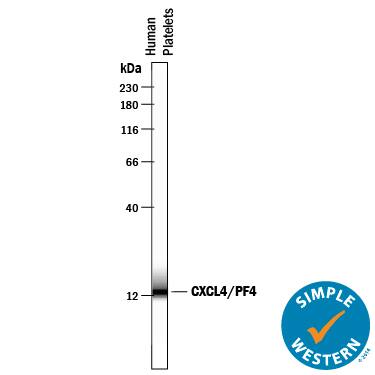Human CXCL4/PF4 Antibody
R&D Systems, part of Bio-Techne | Catalog # MAB795

Key Product Details
Species Reactivity
Validated:
Cited:
Applications
Validated:
Cited:
Label
Antibody Source
Product Specifications
Immunogen
Glu32-Ser101
Accession # P02776.2
Specificity
Clonality
Host
Isotype
Scientific Data Images for Human CXCL4/PF4 Antibody
Detection of Human CXCL4/PF4 by Western Blot.
Western blot shows lysates of human spleen tissue and human platelets. PVDF membrane was probed with 2 µg/mL of Mouse Anti-Human CXCL4/PF4 Monoclonal Antibody (Catalog # MAB795) followed by HRP-conjugated Anti-Mouse IgG Secondary Antibody (Catalog # HAF018). A specific band was detected for CXCL4/PF4 at approximately 11 kDa (as indicated). This experiment was conducted under reducing conditions and using Immunoblot Buffer Group 1.Detection of Human CXCL4/PF4 by Simple WesternTM.
Simple Western lane view shows lysates of human platelets, loaded at 0.2 mg/mL. A specific band was detected for CXCL4/PF4 at approximately 13 kDa (as indicated) using 10 µg/mL of Mouse Anti-Human CXCL4/PF4 Monoclonal Antibody (Catalog # MAB795) . This experiment was conducted under reducing conditions and using the 12-230 kDa separation system.Applications for Human CXCL4/PF4 Antibody
Simple Western
Sample: Human platelets
Western Blot
Sample: Human spleen tissue and human platelets
Formulation, Preparation, and Storage
Purification
Reconstitution
Formulation
Shipping
Stability & Storage
- 12 months from date of receipt, -20 to -70 °C as supplied.
- 1 month, 2 to 8 °C under sterile conditions after reconstitution.
- 6 months, -20 to -70 °C under sterile conditions after reconstitution.
Background: CXCL4/PF4
CXCL4, also known as Platelet Factor 4, is a member of the CXC chemokine family, CXCL4. Human CXCL4 is a 101 amino acid (aa) protein with a 32 aa signal sequence and a 70 aa mature protein. CXCL4 has homology with IL-8 and beta-thromboglobulin. Human and mouse CXCL4 share a 64% identity. CXCL4 contains several heparin-binding sites at the C-terminal region. The active protein consists of a tetramer composed of individual CXCL4 subunits. Megakaryocytes synthesize CXCL4 and store it as tetramers in alpha-granules. The CXCL4 tetramers are secreted by activated platelets and can be measured at micromolar levels in serum. In contrast to other CXC chemokines, CXCL4 lacks chemotactic activity for polymorphonuclear granulocytes. CXCL4 does not contain an ELR motif. However, many other functions have been observed for CXCL4. CXCL4 is involved in monocyte survivial and differentiation into macrophages, and it has anti-angiogenic activity. CXCL4 has been demonstrated to inhibit the binding of FGF-2 to high-affinity receptors and its subsequent internalization. Cell surface neutrophil chondroitin sulfate chains serve as CXCL4 binding sites; affinity is controlled by the degree of sulfation of these chains.
References
- Poncz, M. et al. (1987) Blood 69:219.
- Scheuerer, B. et al. (2000) Blood 95:1158.
- Perollet, C. et al. (1998) Blood 91:3289.
- Petersen, F. et al. (1998) J. Immunol. 161:4347.
- Petersen, F. et al. (1999) J. Biol. Chem. 274:12376.
- Watanabe, O. et al. (1999) J. Hum. Genet. 44:173.
Alternate Names
Gene Symbol
UniProt
Additional CXCL4/PF4 Products
Product Documents for Human CXCL4/PF4 Antibody
Product Specific Notices for Human CXCL4/PF4 Antibody
For research use only

